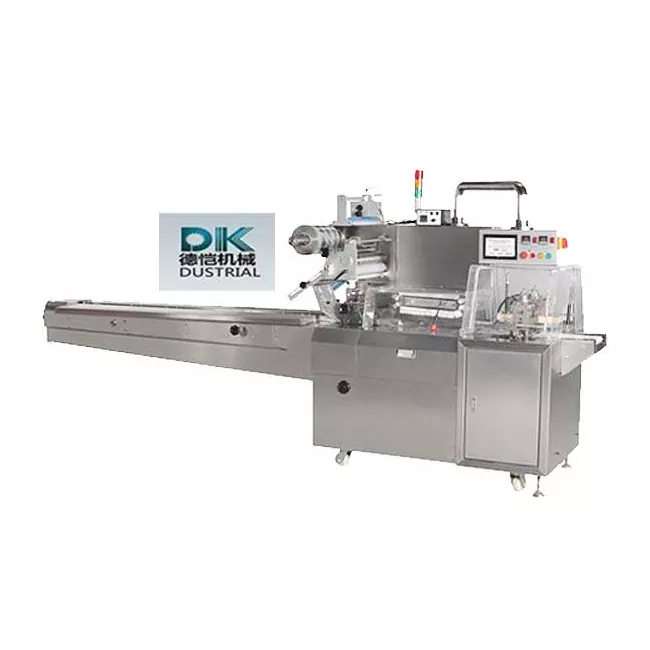The Technological Evolution of Pillow Packaging Machines
2025-11-07
From their rudimentary beginnings to the sophisticated systems of today, pillow packaging machines have undergone a significant technological evolution. This journey has been driven by the relentless pursuit of higher speed, greater accuracy, enhanced flexibility, and improved user control. The modern packaging machine is no longer just a mechanical workhorse; it is a fully integrated mechatronic system, deeply embedded with digital intelligence.
The Mechanical Foundation
Early pillow packaging machines were predominantly mechanical. Their operation relied on cams, gears, chains, and shafts to synchronize the various movements—film pull-down, jaw closure, and product insertion. While robust, these mechanical systems had limitations. Changing package sizes was a time-consuming process involving manual adjustment of multiple components, leading to significant downtime. Speeds were limited by the inertia of heavy mechanical parts, and fine-tuning the process was more an art than a science.
The Revolution of Servo Technology
The single most transformative advancement in pillow packaging technology has been the widespread adoption of servo motors. Replacing mechanical drives with independently controlled digital servos has unlocked unprecedented levels of performance and flexibility.
A modern, all-servo pillow packaging machine features individual servo motors for the film unwind, the longitudinal sealer, the film pull-down belts, and the cross-sealing jaws. This "electronic shaft" setup offers profound benefits:
Quick Changeover: Package size changes, which once took hours, can now be accomplished in minutes. The operator simply selects the new product recipe from a touchscreen Human-Machine Interface (HMI), and all servos automatically reposition themselves to the new specifications. This drastically increases production flexibility and reduces waste during transitions.
Enhanced Precision: Servos provide extremely precise motion control. This allows for more accurate film positioning, gentler product handling (especially for fragile items), and perfect synchronization between the product feeder and the packaging machine.
Reduced Mechanical Complexity and Maintenance: Eliminating complex gearboxes, camshafts, and chains reduces the number of wear parts. This leads to lower long-term maintenance costs, less noise, and improved machine reliability.
Advanced Motion Profiles: Servo control allows for sophisticated motion curves. For instance, the sealing jaws can follow the film perfectly during the sealing moment (registration) and then quickly retract and return to their start position, enabling higher operating speeds.
The Rise of Smart Controls and HMI
The brain of the modern machine is its Programmable Logic Controller (PLC) and the intuitive HMI, typically a color touchscreen. This interface provides operators with complete control and visibility over the packaging process. Key features include:
Recipe Management: Storage of hundreds of product recipes for instant recall.
Real-Time Monitoring: Display of key parameters like speed, temperature, and count.
Diagnostic Alarms: Visual and auditory alerts for issues like film breakage, low product feed, or seal temperature deviation, often with guided troubleshooting.
Data Connectivity: Integration with factory networks (Industry 4.0) for data logging, production reporting, and remote monitoring.
Advanced Features for Enhanced Performance
Beyond servo control, modern machines incorporate several other advanced technologies:
Optical Registration Systems: For printed films, a photoelectric sensor detects a registration mark on the film. The control system then adjusts the film feed in real-time to ensure the print is always perfectly positioned on every package, avoiding crooked graphics.
Inert Gas Flushing (Modified Atmosphere Packaging - MAP): For fresh produce, meats, and snacks, a gas flush system injects a mixture of gases (like Nitrogen and CO2) into the package just before the final seal, displacing oxygen to dramatically extend shelf life.
Advanced Sealing Jaws: Designs have evolved to include dual-lane sealing for double productivity, and quick-change jaw assemblies to further reduce changeover time for different film types.
The evolution of the pillow packaging machine is a clear testament to the industry's drive for innovation. By transitioning from purely mechanical systems to intelligent, servo-driven mechatronic platforms, these machines have become faster, smarter, and more adaptable, meeting the ever-increasing demands of modern manufacturing.
 English
English




